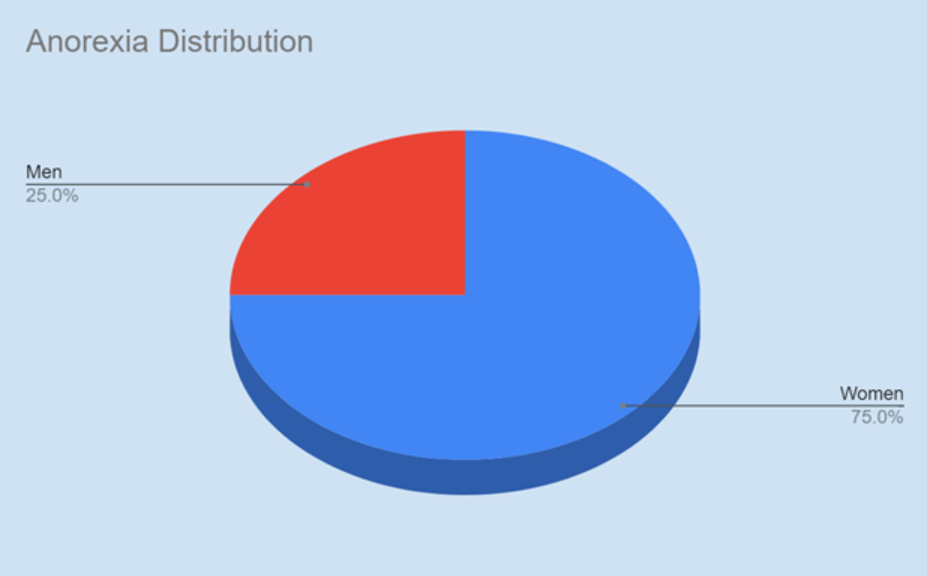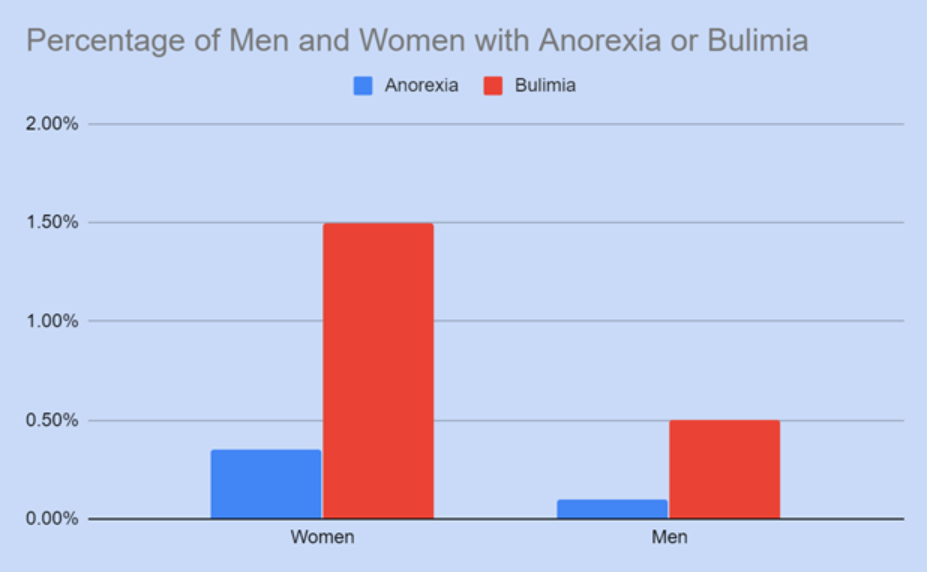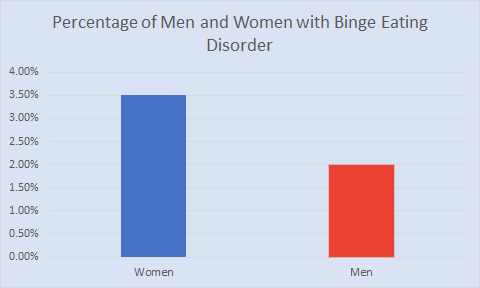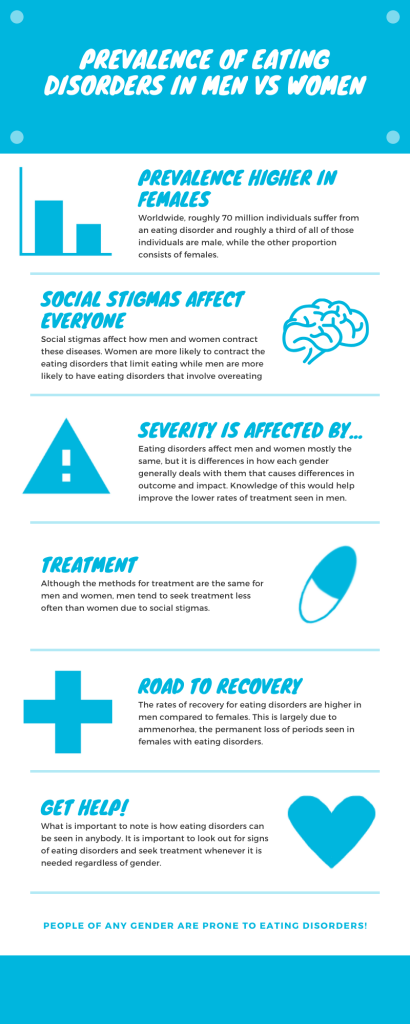10
Randy Fang
How do men generally get eating disorders compared to women?
It is no surprise that most men’s ideal body is a large, muscular body. In contrast, women generally set their goals to achieve a thin, toned body. Social media impacts how individuals feel about their bodies as well. In a study observing social media use and body satisfaction, it was observed that higher social media usage tends to be paired with a lower body satisfaction (Strother et al., 2012). Low body satisfaction is also linked to higher rates of eating disorders. The cultural differences of ideal body types result in women developing more eating disorders. While men tend to consume more foods, women attempt to limit their calories, and both can be done so in very unhealthy ways (Robinson et al., 2012).
The prevalence of eating disorders in men is much lower than in women. However, this does not mean men are not susceptible to these diseases since there are plenty who struggle with them. Worldwide, approximately 70 million individuals suffer from an eating disorder, and roughly a third of those individuals are male (American Addiction Centers, n.d.). This number may be surprisingly high for men, but this may be because of social stigmas revolving around men and these disorders. An ideal, strong physique is greatly related to eating disorders in men. Men concerned with their body appearance are more likely to undergo harmful dietary practices, such as purging (Reas, & Stedal, 2015). In a survey conducted by the British Journal of Psychiatry, roughly 8% of men concerned with their physical appearance reported extreme dietary practices (Murray et al., 2016). Women generally have higher standards and pressure to be attractive. A higher percentage of women are concerned with their body image than men (Murray et al., 2016).
Aside from social media and other influences, eating disorders are more common in women than men because of brain differences. In a study using virtual reality, women who looked down and saw an obese or overly skinny virtual body experienced higher levels of emotions such as anger or fear (Whiteman, 2016). Women with anorexia also have different levels of chemicals in the brain (Engel, n.d.). These differing levels of chemicals can cause overactive and repetitive behaviors that fuel the repetitive habits of eating disorders (Engel, n.d.). Women are also more likely to experience negative emotions when discussing body image and eating disorders (Shirao et al., 2005). These factors prove that eating disorders are not only a disease caused by social factors but are also influenced by individual factors.
Prevalence of eating disorders in men and women
Anorexia is seen in roughly 0.35% of all women and seen in roughly 0.1% of all men (“Statistics & Research on Eating Disorders,” 2019). Roughly 1% to 2% of all females will have anorexia at least once in their lifetime, while it is around .1% to .3% in males (“Statistics & Research on Eating Disorders,” 2019). Males contribute to 25% of the anorexic population but actually have higher chances of dying to the disease due to getting treatment at later stages.

Bulimia is a bit more common than anorexia and exists in roughly 1.5% of women and 0.5% of men in the United States (“Statistics & and Research on Eating Disorders,” 2019). Nonspecified eating disorders are seen in roughly 60% of the population and do not seem to be more or less common between males and females (“Statistics & Research on Eating Disorders,” 2019).

Binge eating disorder is another eating disorder that is seen in roughly 3.5% of all women and roughly 2% of men (“Statistics & Research on Eating Disorders,” 2019). When surveyed about binge eating disorder, women reported higher rates of loss of control of eating, and men reported higher rates of accidental overeating.

In a study following 500 adolescent females until adulthood, 5.2% of the study participants met requirements for at least one of the DSM 5 criteria for anorexia, bulimia, or binge eating disorder. When nonspecified eating disorder symptoms were added to this, 13.2% of the group met requirements for eating disorders (Stoving et al., 2011). It is also important to note that broader definitions of each disorder will result in the disease becoming more common.
Stigma of eating disorders in men
Due to a combination of social, cultural, and other factors, eating disorders in men generally have a perceived social stigma around them. When viewed as a disorder that is stemmed from a desire to achieve a thin, attractive body, eating disorders tend to be seen as non-masculine (Robinson et al., 2012). In multiple studies conducted using face to face interviews regarding eating disorders, there is generally a more noticeable expression of embarrassment or hesitance in men when admitting to having an eating disorder compared to women (Mond, & Arrighi, 2011). When surveyed, men generally had a less sympathetic view towards those with eating disorders and considered it less of a severe health problem. Generally, men also considered bulimia to be caused mostly by a lack of will power. Although this is not the case for all, it is observed as a general trend in many populations (Stoving et al., 2011). Social stigmas, such as the ones revolving around this health issue, cause many problems. If it is not considered normal for a man to struggle with these problems, they are less likely to reach out to others. It is important to realize that these diseases can be seen in men as well, even if it is not discussed as much. These diseases work the same way in men as with women with few differences in how they impact the lives of each gender.
Gender differences in eating disorder prognosis
Prognosis of anorexia development in men and women are different. Higher death rates are seen in those with anorexia who do not seek treatment. Roughly 20% die because of failure to receive treatment. Because the male population has been observed to seek treatment less than women for eating disorders, men have a higher death rate (American Addiction Centers, n.d.). Although more men die, women suffer lifelong problems from the disease, with 39% of women recovering back to full health and 59% of men recovering to full health (American Addiction Centers, n.d.). This is due to damage from a condition called amenorrhea, which is the most common type of long term damage seen in women suffering from eating disorders (American Addiction Centers, n.d.). However, in treatment, men and women with eating disorders do not differ significantly in terms of mental measurements or response to treatments (Stoving et al. 2011). Men with eating disorders have a higher chance to have other problems such as alcoholism, while women with eating disorders displayed higher likelihood to have major depression as well as sexual abuse (Lavender et al., 2010).
Summary
Although these diseases may seem statistically different, eating disorders impact men and women all the same. It is mainly the many cultural and social factors that cause one to develop eating disorders. Social stigmas create a large health disparity in men who develop the disease and those who seek treatment. Many resources can be used if an individual has an eating disorder or is suspected to be dealing with one. Do not hesitate to seek help when dealing with these disorders, because the sooner one gets treatment, the better the outcome. For a recap on this information, see the infographic below.

Review Questions
1. When surveyed about binge eating disorder, women tend to overeat more often due to *
a. Loss of control
b. Accidental overeating
c. Poor dieting skills
d. Hormones
2. Men generally seek treatment less often due to
a. Lower perception of severity for ED
b. Social stigmas
c. Higher death rates
d. Pride
3. True or False? Women have higher remission rates for EDs due to amenorrhea.
a. True
b. False
References
American Addiction Centers. (n.d.). Anorexia in men and boys: Treatment and statistics. https://americanaddictioncenters.org/male-eating-disorders/anorexia
Engel, B., (n.d.). Gulf Bend Center. Causes of eating disorders – Biological. https://www.gulfbend.org/poc/view_doc.php?type=doc&id=11748&cn=46
Lavender, J. M., Young, K. P. D., & Anderson, D. A. (2010). Eating disorder examination questionnaire (EDE-Q): Norms for undergraduate men. Eating Behaviors, 11(2), 119–121. doi: 10.1016/j.eatbeh.2009.09.005
Mond, J. M., & Arrighi, A. (2011). Gender differences in perceptions of the severity and prevalence of eating disorders. Early Intervention in Psychiatry, 5(1), 41–49. doi: 10.1111/j.1751-7893.2010.00257.
Murray, S. B., Griffiths, S., & Mond, J. M. (2016). Evolving eating disorder psychopathology: Conceptualizing muscularity-oriented disordered eating. British Journal of Psychiatry, 208(5), 414–415. doi: 10.1192/bjp.bp.115.168427
National Eating Disorders Association. (2018, February 26). Eating disorders in men & boys. https://www.nationaleatingdisorders.org/learn/general-information/research-on-males
Reas, D. L., & Stedal, K. (2015). Eating disorders in men aged midlife and beyond. Maturitas, 81(2), 248–255. doi: 10.1016/j.maturitas.2015.03.004
Robinson, K. J., Mountford, V. A., & Sperlinger, D. J. (2012). Being men with eating disorders: Perspectives of male eating disorder service-users. Journal of Health Psychology, 18(2), 176–186. doi: 10.1177/1359105312440298
Shirao, N., Okamoto, Y., Mantani, T., Okamoto, Y., & Yamawaki, S. (2005). Gender differences in brain activity generated by unpleasant word stimuli concerning body image: an fMRI study. British Journal of Psychiatry, 186(1), 48–53. doi: 10.1192/bjp.186.1.48
Statistics & Research on Eating Disorders. (2019, April 24). https://www.nationaleatingdisorders.org/statistics-research-eating-disorders
Støving, R. K., Andries, A., Brixen, K., Bilenberg, N., & Hørder, K. (2011). Gender differences in outcome of eating disorders: A retrospective cohort study. Psychiatry Research, 186(2-3), 362–366. doi: 10.1016/j.psychres.2010.08.005
Strother, E., Lemberg, R., Stanford, S. C., & Turberville, D. (2012). Eating disorders in men: Underdiagnosed, undertreated, and misunderstood. Eating Disorders, 20(5), 346–355. doi: 10.1080/10640266.2012.715512
Whiteman, H. (2016, October 16). Why are women more vulnerable to eating disorders? Brain study sheds light. Medical News Today. https://www.medicalnewstoday.com/articles/313466#Using-virtual-reality-to-assess-the-brains-response-to-body-appearance
the quality or state of being prevalent; generally or widely accepted, practiced, or favored
the form or structure of a person's body; bodily makeup
behavior to induce weight loss or manipulate body shape, including self-induced vomiting, misuse of laxatives and medications, excessive exercise, and fasting
https://www.healthline.com/health/eating-disorders/purging-disorder
an artificial environment which is experienced through sensory stimuli (such as sights and sounds) provided by a computer and in which one's actions partially determine what happens in the environment
The Diagnostic and Statistical Manual of Mental Disorders, 5th Edition - the handbook used by health care professionals in the United States and much of the world as the authoritative guide to the diagnosis of mental disorders
https://www.psychiatry.org/psychiatrists/practice/dsm/feedback-and-questions/frequently-asked-questions
regarded in a specified way —used to say how something or someone is seen or thought of
given to, marked by, or arising from sympathy, compassion, friendliness, and sensitivity to others' emotions
the prospect of recovery as anticipated from the usual course of disease or peculiarities of the case
abnormal absence or suppression of menses (the menstrual flow)
markedly distinct in quality or character
